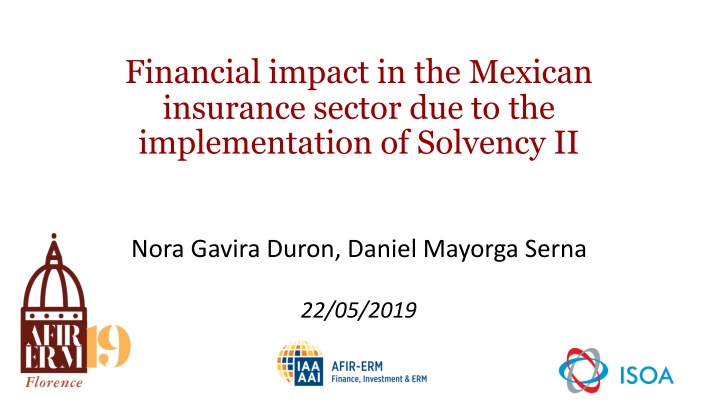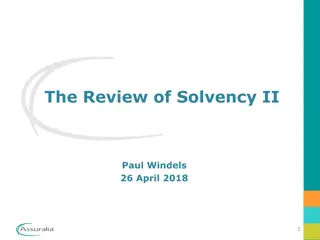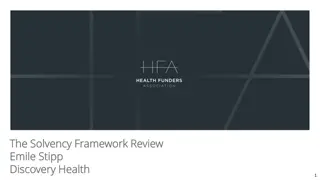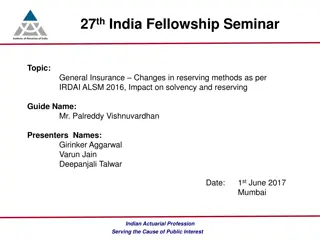Impact of Solvency II on Mexican Insurance Sector
The study examines the financial impact of the implementation of Solvency II in the Mexican insurance sector, focusing on differences between foreign and domestic insurance companies. Data from 92 insurance companies over a period from 2003 to 2018 is analyzed to evaluate changes in performance metrics such as ROA and ROE before and after the regulatory change. The empirical strategy involves a difference-in-difference model to assess the effectiveness of the regulatory change on insurers. The findings aim to shed light on how regulatory changes affect insurance companies in Mexico.
Download Presentation

Please find below an Image/Link to download the presentation.
The content on the website is provided AS IS for your information and personal use only. It may not be sold, licensed, or shared on other websites without obtaining consent from the author.If you encounter any issues during the download, it is possible that the publisher has removed the file from their server.
You are allowed to download the files provided on this website for personal or commercial use, subject to the condition that they are used lawfully. All files are the property of their respective owners.
The content on the website is provided AS IS for your information and personal use only. It may not be sold, licensed, or shared on other websites without obtaining consent from the author.
E N D
Presentation Transcript
Financial impact in the Mexican insurance sector due to the implementation of Solvency II Nora Gavira Duron, Daniel Mayorga Serna 22/05/2019
Introduction Introduction The Mexican Insurance Sector has passed through important regulatory changes for the last ten years in which one of the principal guidelines of these laws was to push these entities to adequate to international normativity. However, the effect of this regulatory change might not be the same for all of them, especially between foreign and domestic ones. While the former might not show any effect in their performance due to they were already adjusted to the international normativity, but the latter might be affected because of the delay in the law. 2
Data Description Data Description We collect data from the entire registered insurance companies and we analyze financial data for the years 2003 to 2018, which is released by the National Insurance and Bonding Commission (its acronym in Spanish, CNSF, Comisi n Nacional de Seguros y Fianzas). This information shows the historical financial data for 92 insurance companies, such as Balance Sheet, Income Statement, Insurance portfolio and financial ratios. However, the first two quarters of 2016 are not available, due to the regulator allowed insurance companies to delay publishing their information until the changes in the law were applied until the third quarter of 2016. We separated the insurance companies between Domestic and Foreign in order to observe differences in total Assets, Liabilities, Equity and from measures such as ROA and ROE. 3
Sample Selection Sample Selection The time framework of our analysis is eight quarters before the regulatory change and eight quarters following its implementation, to capture the before and after-time window of the implementation. Then, we selected only insurance entities that appear for all the quarter of our time framework We keep only entities that maintain their foreign or domestic classification during all the time span of our analysis. We calculate the average of the quarterly information by year in order to obtain five periods of financial information for each entity. Our final sample contains a balanced dataset which contains 62 insurance companies and a total of 310 observations. 4
Empiric Strategy Empiric Strategy In order to evaluate the change effectiveness in law for the insurance sector, we will apply the next model called difference-in-difference: ( ? ?? ?) = ? ? + ? ?1 Foreign? ?+? ?2 Foreign? ? ? ?? ?? ?? ?? ?+? ?3? ?? ?, 1 + ? ? + ? ?? ?? ? Where: ( ? ?? ?) = represents the growth rate of the dependent variable of the Insurer i at time t. Foreign? ? = is a dummy variable, which is equal to 1 if the Insurer Company belongs to a Foreign Group, 0 otherwise. ? ?? ?? ?? ?? ? = is a dummy variable, which is equal to 1 for the quarters following the implementation of the regulation, 0 otherwise. ??, 1 = represents the lag control variables vector. ? ? = reflects the dummy variables fixed-effects. ??? = error term 5
Variables Definition Variables Definition As a first measure for the Insurers risk, we will use a traditional measure in the financial investigation, which is the Z-score. Our second stability measure is the volatility of ROA. For our performance measures, we use ROA and ROE. 6
Parallel Trends Analysis Parallel Trends Analysis Before conducting our investigation using the difference-in-difference estimations. We verify through a parallel trends analysis the behaviour of the dependent variables between the two groups in the periods prior to the treatment. The aim of this analysis is to observe that in case of the absence of the regulatory change the treatment group have behaved similarly to the control group. 7
Figure 1. Description of the aggregated income for the Mexican Insurance Sector from 2003 to 2018 Data source:/InstitucionesSociedadesMutualistas/Paginas/informacionfinanciera.aspx, last access 14/March/2019. 8
Findings Findings We find that the implementation of the law affected positively risk in terms of Z-score but we do not find evidence in terms of volatility of ROA. Also, Outputs reveal that insurance companies enhance performance levels of foreign insurance entities not only in terms of ROA but also in terms of ROE. We confirm that domestic insurance companies depict the oposite behaviour for thier risk and performance levels. 10
Robustness Checks Robustness Checks First, we rerun regressions excluding large insurance companies (more than MXP 50,000,000 thousand) in order to observe if results are influenced by the large entities of the sector. Second, we grouped insurance companies according to their holding group. Third, we run a placebo test, in which randomly allocate the foreign category among entities in order to create another fictional treatment and control group. Finally, we rerun regression to observe the effects of the implementation on the law but now over domestic entities from the sample. 11
Conclusions Conclusions This study provides evidence that the implementation of the law in 2016 succeeded partially by enhancing risk and performance levels but only for the foreign insurance companies, while it erodes risk of default and performance ratios for the domestic insurance companies. Policymakers should consider better strategies to be applied in the implementation phase of laws focused to adopt the international standards of Solvency II which are targeted to be fulfilled in the following years in order to avoid affecting domestic entities as well as local economies. 12
Parallel Trends Analysis Note: Figure 2 shows the behaviour between control and treatment groups of the dependent variables in the periods prior to the implementation of the law. The treatment group is represented by a continuous line whereas the control group is represented by a dotted line.
Table 6. Regressions without large entities (1) (2) (3) (4) Volatility ROA Z-score(ln) ROA ROE Foreign 0.018 (0.343) 0.38** (0.072) 0.10** (0.016) -0.037 (0.115) 0.0089 (0.009) -0.59 (2.878) -0.24 (0.364) 0.053 (0.048) 0.10*** (0.010) -0.18 (0.124) -0.0030 (0.008) 3.03 (2.994) 0.032 (0.023) (0.100) 0.022** 0.066** (0.004) (0.008) -0.0036* 0.0030 (0.001) (0.002) -0.015 (0.006) (0.017) -0.0014 -0.0038 (0.001) (0.002) 0.43 (0.170) (0.436) 0.11 Foreign*Regulatory Change Inflation(lag) -0.057* Size(lag) HHI(lag) 1.46* Constant Holding and Year FE Observations R-squared Yes 259 0.28 Yes 264 0.23 Yes 265 0.089 Yes 265 0.058 14
Table 8. Placebo test regressions (1) Z-score(ln) Volatility ROA ROA (2) (3) (4) ROE Foreign 0.61 (0.460) -0.15 (0.081) -0.016 (0.021) -0.0052 (0.100) -0.016 (0.013) 0.89 (2.966) 1.46 (0.751) 0.15 (0.068) 0.11** (0.015) -0.16 (0.108) 0.0074 (0.010) 1.98 (2.888) -0.049 (0.035) -0.0082 (0.010) -0.0093** 0.0011 (0.002) -0.014 (0.006) -0.0030* -0.0044 (0.001) 0.54* (0.171) -0.17 (0.088) 0.074 (0.027) Placebo*Regulatory Change Inflation(lag) (0.005) -0.055* (0.016) Size(lag) HHI(lag) (0.002) 1.45* (0.419) Constant Holding and Year FE Observations R-squared Yes 304 0.25 Yes 309 0.22 Yes 310 0.083 Yes 310 0.062
Table 9. Regression Domestic Insurance Companies (1) Z-score(ln) Volatility ROA ROA (2) (3) (4) ROE Domestic -0.64 (0.479) -0.35** (0.068) -0.041 (0.016) -0.028 (0.098) -0.024 (0.011) 2.68 (3.164) -1.43 (0.732) -0.086 (0.036) 0.068*** (0.008) -0.16 (0.110) -0.0035 (0.008) 4.29 (3.435) 0.054 (0.032) -0.019** -0.058** (0.004) -0.011*** -0.021*** (0.001) -0.015 (0.006) -0.0034** -0.011*** (0.000) 0.54* (0.133) 0.20 (0.075) Domestic*Regulatory Change (0.008) Inflation(lag) (0.001) -0.054* (0.017) Size(lag) HHI(lag) (0.001) 1.76* (0.393) Constant Entity and Year FE Observations R-squared Yes 304 0.26 Yes 309 0.22 Yes 310 0.088 Yes 310 0.060























